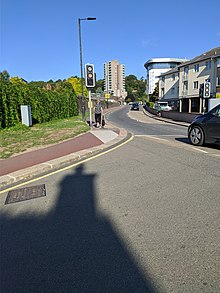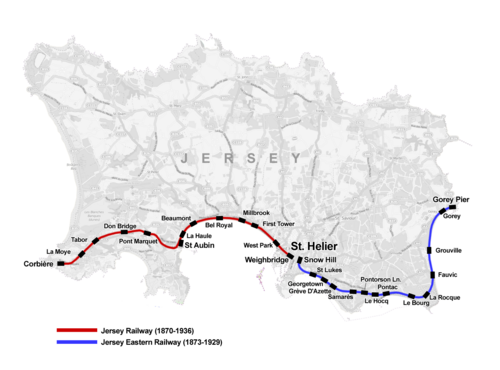
Jersey – the largest of the Channel Islands – has been an island for around 6,000 years. Early inhabitation is evidenced by various neolithic monuments and hoards. In the 10th century, Jersey became part of Normandy. When the Normans conquered England in the 11th century, Jersey remained a part of the Duchy of Normandy, but when Normandy and England were finally split in the 13th century, the Channel Islands remained loyal to the English Crown, splitting Jersey politically from mainland Normandy.
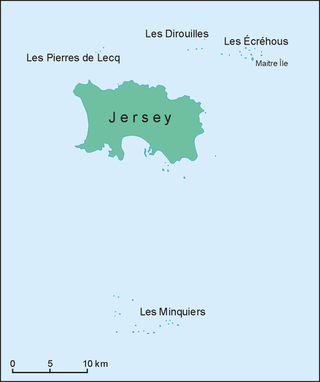
Jersey is the largest of the Channel Islands, an island archipelago in the St. Malo bight in the western English Channel. It has a total area of 120 square kilometres (46 sq mi) and is part of the British Isles archipelago. It lies 22 kilometres from the Cotentin Peninsula in Normandy, France and about 161 kilometres from the south coast of Great Britain. Jersey lies within longitude -2° W and latitude 49° N.

St Helier is the capital of Jersey, the largest of the Channel Islands in the English Channel. St Helier has a population of 35,822 – over one-third of the total population of Jersey – and is one of the twelve parishes of Jersey. The town of St Helier is the largest settlement and only town of Jersey. The town consists of the built-up areas of St Helier, including First Tower, and parts of the parishes of St Saviour and St Clement, with further suburbs in surrounding parishes. The greater part of St Helier is rural.

St Brelade is one of the twelve parishes of Jersey in the Channel Islands. It is around 7 kilometres (4.3 mi) west of St Helier. Its population was 11,012 as of 2021.

St Clement is one of the twelve parishes of Jersey in the Channel Islands. Its parish hall is around 3.6 kilometres (2.2 mi) south-east of St Helier. The parish has a population of 9,221 and is the second most densely populated.

St Martin is one of the twelve parishes of Jersey in the Channel Islands. It is 5.5 kilometres (3.4 mi) north-east of St Helier. It has a population of 3,948. The parish covers 10.3 km2 (4.0 sq mi).

Gorey is a village in the parishes of St Martin and Grouville on the east coast of Jersey. The harbour is one of the three main harbours of the island, and is located in St Martin. The main centre of the village is located at Gorey Pier near Mont Orgeuil Castle, a 13th century fortification, in St Martin, while there is a small community with a few shops and restaurants. The church in the village is known as Gouray Church.

St. Aubin is a town and port in St. Brelade in Jersey, the largest of the Channel Islands. It is located on the western end of St. Aubin's Bay, on the south coast of the island, opening out into the Gulf of Saint-Malo.
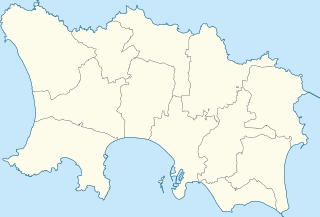
The parishes of Jersey are the civil and religious administrative districts of Jersey in the Channel Islands. All have access to the sea and share a name with their ancient parish churches. The parishes and roles within them are based on ancient Jersey law, drawing from the Norman customary law system. As such, many of the parish roles and structures have often been ill-defined.
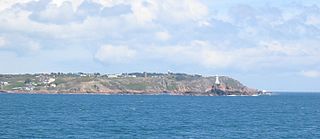
La Corbière is the extreme south-western point of Jersey in St. Brélade. The name means "a place where crows gather", deriving from the word corbîn meaning crow. However, seagulls have long since displaced the crows from their coastal nesting sites.

Jersey Airport is an international airport located in the parish of Saint Peter, 4 NM west northwest of Saint Helier in Jersey, in the Channel Islands.

Elizabeth Castle is a castle and tourist attraction, on a tidal island within the parish of Saint Helier, Jersey. Construction was started in the 16th century when the power of the cannon meant that the existing stronghold at Mont Orgueil was insufficient to defend the Island and the port of St Helier was vulnerable to attack by ships armed with cannons.

The Jersey Railway was opened in 1870 and was originally a standard gauge railway, 3+3⁄4 miles (6.0 km) long, in Jersey in the Channel Islands. Converted to narrow gauge in 1884 and extended giving a length of 7+3⁄4 miles (12.5 km), the line closed in 1936.

The Jersey Eastern Railway was a standard gauge railway that began operations on 6 August 1873 in Jersey. The line closed on 21 June 1929.

Victoria Avenue is a major road in Jersey, connecting the capital St Helier to Bel Royal in St Lawrence, also providing access to the western part of the A1 for non-bus traffic, due to a bus gate that prevents traffic from the A1 continuing on the A1.

St Helier railway station was a railway station in Saint Helier, the capital of Jersey in the Channel Islands. Opened in 1870 by the Jersey Railway, it was situated on the western side of the Weighbridge area, now Liberation Square. The station was referred to as "St. Helier (Weighbridge)" to distinguish it from another railway terminus opened by the Jersey Eastern Railway in 1873 in St Helier at Snow Hill. The station was in passenger operation until the line closed in 1936.

St Helier railway station was the terminus of the Jersey Eastern Railway (JER) in Saint Helier, the capital of Jersey in the Channel Islands. Opened in 1874, it was situated in a railway cutting at the base of Mont de la Ville below Fort Regent. The station was referred to as St. Helier to distinguish it from another railway terminus opened by the Jersey Railway in 1873 at the Weighbridge in St Helier. The station was in passenger operation until the line closed in 1929. Today the site is occupied by the Snow Hill car park.

St Aubin railway station, also known as St Aubins was a railway station in Saint Aubin, a port in Jersey in the Channel Islands. Opened in 1870 by the Jersey Railway, it was in passenger operation until the line closed in 1936.

The perquages are a series of routes in Jersey, Channel Islands. Some claim the routes that offered sanctuary to malefactors to leave the island. All except St Ouen and St Martin lead to the south coast. For example, St Mary, St John and St Lawrence leave via St Peter's Valley and Beaumont.
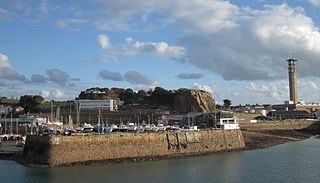
Mount Bingham also known as South Hill is a hill in St. Helier, the capital of the Channel Island of Jersey. It is named after Sir Francis Richard Bingham who served as Lieutenant Governor of Jersey from 1924 until 1929. A road that circles the coastal side of Mount Bingham is known by the same name.



